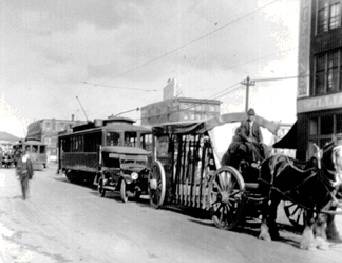Citizens' Alliance: Difference between revisions
(categories) |
(PC and protected) |
||
| Line 1: | Line 1: | ||
'''<font face = Papyrus> <font color = maroon> <font size = 4>Historical Essay</font></font> </font>''' | |||
''by Ben Ratliff'' | |||
[[Image:rulclas1$teamsters-in-1903.jpg]] | [[Image:rulclas1$teamsters-in-1903.jpg]] | ||
'''Teamsters along the waterfront, 1903.''' | '''Teamsters along the waterfront, 1903.''' | ||
''Photo: San Francisco History | ''Photo: San Francisco History Center, SF Public Library'' | ||
In 1903, a new nationwide open-shop movement began. The National Association of Manufacturers called for businesses across the United States to campaign collectively for an end to union power. NAM'S president, David M. Parry, was a zealous opponent of all labor organizations across the country. San Francisco, long held to be the stronghold of union power in the West, naturally became a target of the open-shop movement. | In 1903, a new nationwide open-shop movement began. The National Association of Manufacturers called for businesses across the United States to campaign collectively for an end to union power. NAM'S president, David M. Parry, was a zealous opponent of all labor organizations across the country. San Francisco, long held to be the stronghold of union power in the West, naturally became a target of the open-shop movement. | ||
| Line 15: | Line 19: | ||
In October, 1904, the San Francisco Butchers' Board of Trade ordered members to display placards proclaiming the open shop. The Butchers' Union, at some 500 strong, could have taken action but was persuaded by Olaf Tveitmoe and other conservative leaders not to strike unless the board took direct, negative action on working conditions. | In October, 1904, the San Francisco Butchers' Board of Trade ordered members to display placards proclaiming the open shop. The Butchers' Union, at some 500 strong, could have taken action but was persuaded by Olaf Tveitmoe and other conservative leaders not to strike unless the board took direct, negative action on working conditions. | ||
[[Employers' Association |Prev. Document]] [[BAY AREA COUNCIL |Next Document]] | [[Employers' Association |Prev. Document]] [[BAY AREA COUNCIL |Next Document]] | ||
[[category:Power and Money]] [[category:1900s]] [[category:Labor]] [[category:downtown]] | [[category:Power and Money]] [[category:1900s]] [[category:Labor]] [[category:downtown]] | ||
Revision as of 00:32, 17 January 2009
Historical Essay
by Ben Ratliff
Teamsters along the waterfront, 1903.
Photo: San Francisco History Center, SF Public Library
In 1903, a new nationwide open-shop movement began. The National Association of Manufacturers called for businesses across the United States to campaign collectively for an end to union power. NAM'S president, David M. Parry, was a zealous opponent of all labor organizations across the country. San Francisco, long held to be the stronghold of union power in the West, naturally became a target of the open-shop movement.
The Citizens' Alliance became the local champion of this nationwide crusade, effectively organizing and pressuring local businesses into anti-labor actions. The Citizens' Alliance was led by Herbert George, a union-buster who had made his reputation emasculating the Western Federation of Miners. Unlike the stealthy Employers' Association that had preceded it, The Citizens' Alliance quickly attempted to establish a public presence, claiming to represent the interests of everyone in the community -- except union members. The Citizens' Alliance cleverly appropriated many of the publicity tactics of unions, like picketing and sending out representatives with sandwich boards.
On April 15, 1904, the Citizens' Alliance fired its first volley. It encouraged members of the Stable and Carriage Owners' Association to post signs stating that they would no longer recognize unions in the workplace. The ensuing strike brought 300 to 400 carriage workers out on strike. Despite eventual support from the Hackmen's Union, the strike eventually faltered. The Citizens' Alliance managed to supply strikebreaking carriage makers and hackmen. At the end of August, Mayor Schmitz, who was elected to office under the Union Labor Party ticket, negotiated a settlement with the Stable and Carriage Owners' Association whereby strikers would return work under open-shop conditions with verbal assurances of no discrimination against union members. This unfavorable resolution for labor cast a pall on the Union Party, which had recently come to power under promises of fighting for working class interests. This episode also discredited the Stablemen's Union among its own ranks.
The next battle instigated by the Citizens' Alliance was in the meat industry. Under Alliance pressure, East Bay meat wholesalers and retailers refused union demands for a wage increase and locked out about 150 workers in the Butchers' Union. Once again, those businesses that were more conciliatory to the unions were made to understand that their supplies would be cut off. Union strength waned as the crisis went on, and, though the union survived, it was sorely weakened. However, one vestige of union strength did remain -- The California Cooperative Meat Company -- a labor-owned organization that functioned into the 1920's.
In October, 1904, the San Francisco Butchers' Board of Trade ordered members to display placards proclaiming the open shop. The Butchers' Union, at some 500 strong, could have taken action but was persuaded by Olaf Tveitmoe and other conservative leaders not to strike unless the board took direct, negative action on working conditions.

